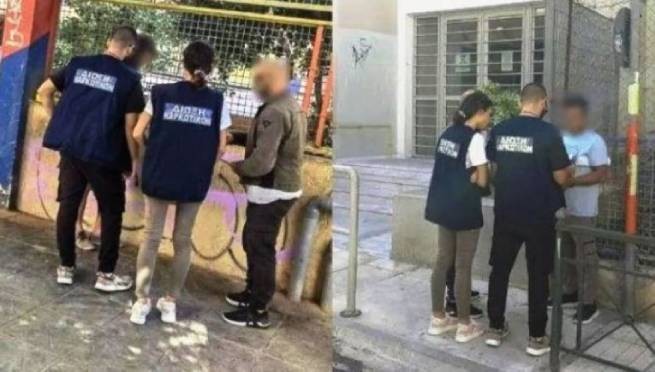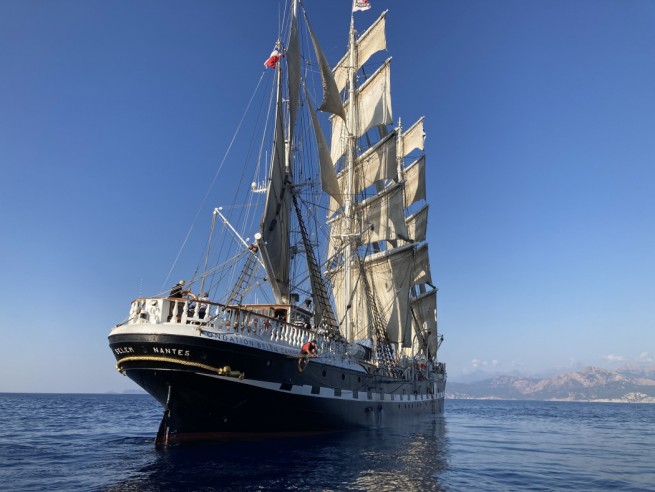The Greek Embassy in Tirana has issued a strong protest, demanding immediate explanations from the office of Albanian President Ilir Meta regarding an exhibition of photographs and maps at the presidential mansion in Tirana, which claims the alleged “genocide” of the Cham Albanians and the “occupation of Albanian territory by Greece,” they said on Friday diplomatic sources.
The photographs, which have been displayed on the outer fence of the Albanian presidential mansion, are accompanied by accusations against Greece of the “Cham Albanian genocide”, as well as maps depicting much of Greece as “occupied Albanian lands.” It should be noted that the organizers conducted a tour of the exhibition to President of Albania Ilir Meta.
Under the slogan “From Albanian Ypir to Preveza” the Tsamids in 1942 collaborated with the Italian and German fascists, creating armed military units against the Greeks. The Tsamids were a group of Albanian-speaking Muslims who reached 20,000 in the early 20th century and lived in the Thesprotia region, in particular in Igoumenitsa, Margariti, Filiates and Paramithia. Albanian propaganda calls this area Tsamuriya.
The name Tsamis is a distortion of the name Tamis, since the Kalamas River was known in antiquity. Today’s Tsamids are the descendants of the Christians of Epirus, Islamized in the 17th century.
Although with the signing of the Lausanne Treaty (1923) with Turkey, the Muslim Tsamids were recognized as “exchange”, with the backstage intervention of Italy in the government of the dictator Theodore Pangalos, they were excluded from the resettlement program and remained in Thesprotia. As it turned out, Muslim Tsamids were used by the fascist regime in Rome for propaganda purposes, sometimes leading bloody incidents on the Greco-Albanian border to justify an attack on Greece in October 1940. Albanian battalions took part in operations on the side of the Italians.
During the Italian-German occupation, the Tsamids collaborated with the occupying forces. In 1942, under the slogan “From Albanian Ypir to Preveza”, they formed KSILIA (“Albanian system of political administration”) with 14 battalions, with the main goal of exterminating the Greek population in the Thesprotia region. The leader of the organization was Nuri Dino Bey, son-in-law of Albanian Prime Minister Sefget Verlachi. “My dedication and the services I have provided to Italy for over 40 years obliges me to tell you what happened recently in Tsamuria, Greece and Southern Albania, where I witnessed and fell victim to an insidious attack that claimed the lives of several Italian soldiers.” begins a letter from Dino Benito Mussolini (February 1943), which exists today in the Italian archives and is indisputable evidence of the role of the Tsamids in causing damage to Greece. When the fascist regime of Mussolini collapsed and Italy surrendered, the Germans took control of the Italians-occupied area of Epirus, continuing to use Tsamis as a support. They even set about setting up a “Gendarmerie Scepetarica” targeting the Greek population of the area.
Tsamides joined the German military forces in joint exercises and acts of violence against the Greeks, culminating in the mass execution of 49 members of Paramithia on September 29, 1943. The resistance newspaper “Epanastatis” wrote about the tragedy:
“At first there were rumors that the arrested would be taken hostage and sent to Ioannina, their families would take care of them and provide them with money, food and various other items. they were executed by the Germans and Muslims after first being forced to dig their own graves. […] After the execution, the Muslims “took the money and other things that they had, took off their clothes and shoes, and threw them into the hole they dug.”
Executions of civilians
Athanasios Gotovos, a professor of pedagogy at the University of Ioannina, who studied German archives in detail, found documents proving that the executions of civilians in Paramithia were based on a list of names compiled by the leadership of the Tsami region. In August 1944, the armed forces of the Tsamids were dealt a significant blow from the national resistance groups of Napoleon Zervas (EDES).
Hundreds of Tsamids, realizing the consequences of what they had done against the Greek population, fled to Albania, taking their families with them. The number of Tsamids who left Epirus at the end of 1944, along with the last remnants of German troops, is estimated at 18,000. By court order, they were stripped of their Greek citizenship, while their property was expropriated and transferred to local residents in the area. In 1945, a special court of Dosilogon Ioannina sentenced 1930 tsamids accused of war crimes to death in absentia.
For the past 25 years, the Tsamis problem has been an indicator of Albanian fanaticism, which has intensified since 2000, and the creation of the state of Kosovo. To distract from the rights of the Greeks of Northern Epirus, but also because of the supporters of voting, the two main Albanian parties in power often raise this issue, talking about the return of the property of the Tsamids and even the return of their descendants to Greece.
Tsamides is hailed as “liberators” – first Italians and then the troops of Nazi Germany in the area of Thesprotia
According to a study by Athanasios Gotovos, professor of pedagogy at the University of Ioannina, there are documents confirming that the local leadership of Tsamida took part in the massacres of the Greeks.
Tsamiki propaganda with a controversial history
– The geography and history that Albanian high school students are taught is provocative and distorted – even King Pyrrhus and the mother of Alexander the Great are presented as Albanians!
– And of course, any connection between the Tsamids and the Nazis and the execution of hundreds of Greek civilians is hidden …
“This year you will learn the geography of the Republic of Albania and other Albanian regions, which, due to historical events, are located in the neighboring Balkan states.” This is how the prologue to the geography textbook, which is taught to high school students in Albania, begins. …
In recent years, students in Albania have been studying the history and geography of “Albanian national territories”, including all of northwestern Greece, where “bloodthirsty” Greeks carried out the “ethnic cleansing” of the Tsamids who dominated most of these territories.
A new generation in a neighboring country learns that they share the same DNA as King Pyrrhus of Epirus and Olympias, the mother of Alexander the Great, and that the Greek hero of the 1821 revolution, Marcos Botsaris, was simply an Albanian mercenary fighting on the side of the Greeks.
Despite recent smiles and warm handshakes between Greek Foreign Minister Nikos Kotzias and Albanian Prime Minister Edi Rama and his colleague Dietmir Busati in Tirana, the differences between the two countries seem to remain unresolved with the Rama government in power. The nationalist climate in the country and attention was focused on the 2016 elections of the Tsamid party, which claimed that Olympus of the ancient Greeks had its roots in … Tsamuria.
Rama’s statements, Tsamid’s “spontaneous” demonstrations at the Albanian Foreign Ministry against Kotzias’s visit are just the tip of the iceberg. In recent years, Tirana has decided to invest in creating a nationalist climate in society, starting with schools.
The examples are illustrative.
The “Albanian regions” (Treva Shqiptare), which remained outside the Albanian state, include Kosovo, parts of Montenegro and Serbia, half of Skopje and, of course, all of northwestern Greece with the prefectures of Florina, Kastoria, Grevena, Ioannina, Preveza, Thesprotia and the northern part of the prefecture of Etholoacarnania.
In particular with regard to Greece, the chapter “Albanian regions in Greece” provocatively mentions the following: “These are Albanian regions that were unjustly annexed to the Greek state in 1913 by the council of ambassadors. Historical events, massive forced displacements of the indigenous Albanian population and the lack of official data make it difficult to identify the Albanian territories in Greece and especially to identify the social and economic problems of these areas.
A provocative map with Albania and neighboring “Albanian regions” adorns the cover of both students’ books and notebooks, calling, for example, to draw areas of Greece where Albanians live, to answer the question “what are the Albanian regions of Greece”, or to mention the “expulsion of Albanians from sides of the Greek authorities “.
“Ethnic cleansing by the Greeks in Tsamuria”
In the book “History of the Albanian People” there is a special chapter dedicated to Tsamuria, which notes that “it is located in the southwestern part of Lower Albania”, and provocatively call it the southern part of Epirus:
“The Greek invasion of Tsamuria in 1913 was marked by atrocities that forced thousands of Tsamids to leave their ancestral homes. The Greek occupiers hastened the expulsion of the Tsamids and the rest of the Albanians in order to destroy the Albanian national element from the territories they occupied,” the authors of the book report, continuing. With the demarcation of borders in 1913, the territories of not only the Ioannina region, but also almost all of Tsamuria, the provinces of Filyatra, Igoumenitsa, Paramithia, Margariti, Parga and Preveza, as well as the regions of Florina, Kastoria and the villages of Grammos passed to Greece. “
Of course, nowhere in the history textbook is there any mention of the collaboration of the Tsamids with the occupying forces during World War II and the mass executions of the local Greek population. Tsamids are presented as “victims” whom the Italian fascists used exclusively in their own interests. “During the war, Tsamuria experienced the greatest tragedy in history, despite Italy’s promises of help. The Greeks burned the villages of Tsamuria and plundered worse than the Italians.”
Although in 2014 the ministries of education of Greece and Albania agreed to remove from textbooks expiatory references or characteristics that cause problems in relations between the two countries, nothing happened. At the time, the current Deputy Minister, despite the fact that Prime Minister Terence Quick, as an opposition MP, asked the Foreign and Education Ministers about “anti-Greek textbooks”, asking the government to ask Tyrana to withdraw them. Head of the MEPs N.D. made a statement on this matter at the European Commission. Manolis Kefalogiannis spoke about the actions of extreme redemption and falsification of history by the acceding country of Albania, which are contrary to the basic principles and values of the EU.
Mercenary Marco Botsaris and the Albanian Olympics
For Albanian historiography, the ancient continental tribes (Thesprotians, Chaons, Molossians, etc.) are of Illyrian, and not Greek, origin, as is commonly believed. Thus, King Pyrrhus of Epirus, the mother of Alexander the Great Olympias and others belong to the “pantheon” of Albanian heroes. Even Marcos Botsaris of Suli, a leading figure in the Greek Revolution of 1821, is presented as … Marco Bochari, an Albanian mercenary who simply fought on the side of the Greek rebels against the Turks. The history textbooks fully reflect the positions of the “intellectual” elite of Albania, which was recently reflected in the new edition of the Albanian encyclopedic dictionary of the country’s Academy of Sciences, funded by the state.
A provocative geography textbook cover where Albania and the “Albanian regions” are beyond borders. Among them is the so-called workbook
“Tsamuria in Geography”, students are invited to draw “Albanian regions” in 1913, excluding the border with Albania
Red dots mark “Albanian centers” in northwestern Greece on the map, while students answer questions about “Greek persecution of the Tsamids”
Used translation from the material of the publication protothema






More Stories
Greece will not give Ukraine either S-300 or Patriot (video interview)
MP beat up his colleague in the Greek Parliament
EU Commission warns Greece and Cyprus against fraud